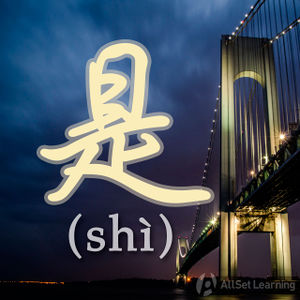Difference between revisions of "Connecting nouns with "shi""
ViktorMugli (talk | contribs) |
Wu.mengmeng (talk | contribs) |
||
| Line 1: | Line 1: | ||
| + | {{Grammar Box}} | ||
The verb ''to be'' is not used in Chinese the same way as it is in English. In Chinese, 是 is for connecting [[nouns]], and is generally not used with [[adjectives]]. | The verb ''to be'' is not used in Chinese the same way as it is in English. In Chinese, 是 is for connecting [[nouns]], and is generally not used with [[adjectives]]. | ||
| Line 58: | Line 59: | ||
[[Category:A1 grammar points]] | [[Category:A1 grammar points]] | ||
| + | {{Basic Grammar|是|A1|N + 很 + Adj|我 <em>很</em> 饿 。|grammar point|ASG17BLH}} | ||
| + | {{Similar|Word order}} | ||
| + | {{Similar|Simple "noun + adjective" sentences}} | ||
Revision as of 02:08, 13 June 2012
-
Level
-
Similar to
-
Used for
-
Keywords
The verb to be is not used in Chinese the same way as it is in English. In Chinese, 是 is for connecting nouns, and is generally not used with adjectives.
Structure
The structure for connecting nouns with 是 is:
Noun 1 + 是 + Noun 2
This is equivalent to "Noun 1 is Noun 2" in English. In terms of sentence elements, the structure is:
Subject + 是 + Object
Chinese does not conjugate verbs. That is, the form of the verb is the same no matter who is doing it. In this case, it is always 是 and never changes. As you can see, it's easy to form simple sentences expressing to be in Chinese.
Examples
| Subject | 是 | Object | |
|---|---|---|---|
| 我 | 是 | 学生 | 。 |
| 她 | 是 | 医生 | 。 |
| 他 | 是 | 老师 | 。 |
| 这 | 是 | 书 | 。 |
| 那 | 是 | 杯子 | 。 |



